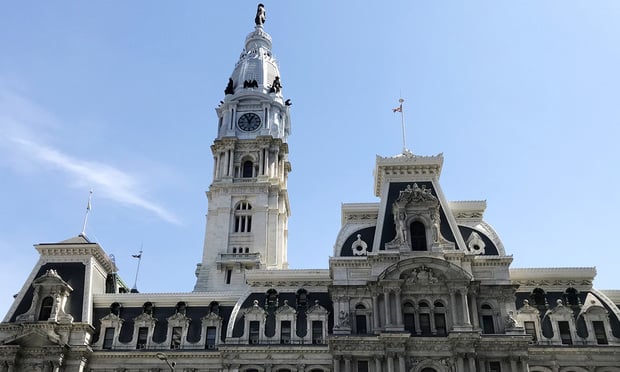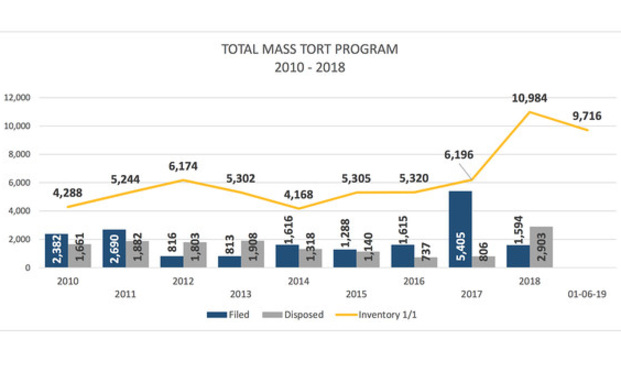Phila. Mass Tort Inventory Saw Record Decline in 2018, Court Reports
Philadelphia's Complex Litigation Center saw a record decline in the number of mass tort cases pending on its dockets over the past year, but overall the inventory remains high.
February 13, 2019 at 05:06 PM
5 minute read
 Philadelphia City Hall building. Photo: Diego M. Radzinschi/ALM
Philadelphia City Hall building. Photo: Diego M. Radzinschi/ALM
Philadelphia's Complex Litigation Center saw a record decline in the number of mass tort cases pending on its dockets over the past year, but overall the inventory remains high.
According to numbers recently released by the court, a total of 9,716 cases were pending in the 11 mass tort programs at the First Judicial District as of early January. That number is a 1,268 decline from the 10,984 cases that were on the mass tort dockets at the beginning of 2018.
The decline is the largest year-to-year drop the court has seen since 2010, which is as far back as available data. Although the court saw 1,594 new cases filed over 2018, it also disposed of 2,903 cases, which was likewise the highest number of mass tort cases that the court disposed of in a single year. But the drop was not enough to erase the staggering growth the court system saw over 2018.
Between 2017 and 2018, the court saw a 77 percent increase in its total inventory, or nearly 4,800 cases added to the dockets. That increase was due mostly to the exponential growth of the Risperdal mass tort, which jumped from 1,945 to 6,200 during that year.
 Credit: First Judicial District of PA: Trial Division-Civil
Credit: First Judicial District of PA: Trial Division-CivilThe decline between 2018 and 2019 was due mostly to the Reglan litigation, which fell 95 percent—from 2,073 at the beginning of the year to 97. Reglan was the largest mass tort program in Philadelphia as recently as mid-2017. The litigation, which stemmed from claims that the drug caused an incurable neurological disorder called tardive dyskinesia, reached a global settlement in early 2017, but the cases remained on the docket for some months, and by late 2017, it still made up nearly 20 percent of the Complex Litigation Center's total inventory.
Risperdal, which has grown to 67 percent of the Complex Litigation Center's inventory, saw little growth over 2018—adding nearly 350 cases, or 6 percent, over the 6,200 that were pending at the beginning of the year. According to attorneys handling the litigation, the explosive growth the court saw over 2017 was due mostly to the parties scrapping a tolling agreement, which led thousands of plaintiffs to file suit in order to preserve their claims.
 Credit: First Judicial District of PA: Trial Division-Civil
Credit: First Judicial District of PA: Trial Division-CivilAlong with Risperdal, litigation over the drug Xarelto and the vena cava filters were the only other mass tort programs to see any growth over the past year.
According to the numbers, the Xarelto program increased by slightly more than 350 cases, or 22 percent, over 2019, growing from 1,619 at the beginning of the year to 1,972 as of early January.
The vena cava filter program added 161 cases, which increased that program from 277 pending cases to 438 by the beginning of the year.
All other mass tort programs saw their numbers drop.
Almost the entire 85-case inventory of the firefighter hearing loss litigation was taken off the dockets. According to the court's numbers, the inventory went from 85 cases to one.
In August, the Pennsylvania Superior Court struck a blow to the plaintiffs in that litigation when it agreed with a trial court judge, who had determined that it was not sufficient for the plaintiffs to rely on industry standards when it came to their proposed safer alternative design, and instead the plaintiffs should have called an expert to support their argument. That ruling came only months after the U.S. Court of Appeals for the Third Circuit dealt the plaintiffs another blow by agreeing with a district court that the plaintiffs' attorneys had failed to investigate the claims before filing suit and therefore needed to cover the attorney fees and costs for bringing the lawsuits.
The pelvic mesh litigation saw a decline of 31 cases, shrinking from 119 in early 2018 to 88 pending as of January. The Yaz, Yasmin, Ocella litigation dropped from 19 cases to three, and the asbestos litigation also saw an 18-case dip, which brought the total number of pending asbestos cases to 571.
When it comes to who is filing cases in Philadelphia, the number of plaintiffs hailing from out of state who filed pharmaceutical cases in the past year dropped four percentage points, from 90 percent to 86 percent.
The number of out-of-state plaintiffs who brought asbestos cases in 2018, however, increased significantly, from 47 percent to 60 percent. That number, which represents 154 new cases being filed by an out-of-state plaintiff, is the highest percentage of asbestos plaintiffs hailing from out of state since at least 2010.
Philadelphia Judge Arnold New, who oversees the Complex Litigation Center, declined to be interviewed for the story.
This content has been archived. It is available through our partners, LexisNexis® and Bloomberg Law.
To view this content, please continue to their sites.
Not a Lexis Subscriber?
Subscribe Now
Not a Bloomberg Law Subscriber?
Subscribe Now
NOT FOR REPRINT
© 2025 ALM Global, LLC, All Rights Reserved. Request academic re-use from www.copyright.com. All other uses, submit a request to [email protected]. For more information visit Asset & Logo Licensing.
You Might Like
View All

The Importance of Federal Rule of Evidence 502 and Its Impact on Privilege
6 minute read
Trending Stories
- 1Gunderson Dettmer Opens Atlanta Office With 3 Partners From Morris Manning
- 2Decision of the Day: Court Holds Accident with Post Driver Was 'Bizarre Occurrence,' Dismisses Action Brought Under Labor Law §240
- 3Judge Recommends Disbarment for Attorney Who Plotted to Hack Judge's Email, Phone
- 4Two Wilkinson Stekloff Associates Among Victims of DC Plane Crash
- 5Two More Victims Alleged in New Sean Combs Sex Trafficking Indictment
Who Got The Work
J. Brugh Lower of Gibbons has entered an appearance for industrial equipment supplier Devco Corporation in a pending trademark infringement lawsuit. The suit, accusing the defendant of selling knock-off Graco products, was filed Dec. 18 in New Jersey District Court by Rivkin Radler on behalf of Graco Inc. and Graco Minnesota. The case, assigned to U.S. District Judge Zahid N. Quraishi, is 3:24-cv-11294, Graco Inc. et al v. Devco Corporation.
Who Got The Work
Rebecca Maller-Stein and Kent A. Yalowitz of Arnold & Porter Kaye Scholer have entered their appearances for Hanaco Venture Capital and its executives, Lior Prosor and David Frankel, in a pending securities lawsuit. The action, filed on Dec. 24 in New York Southern District Court by Zell, Aron & Co. on behalf of Goldeneye Advisors, accuses the defendants of negligently and fraudulently managing the plaintiff's $1 million investment. The case, assigned to U.S. District Judge Vernon S. Broderick, is 1:24-cv-09918, Goldeneye Advisors, LLC v. Hanaco Venture Capital, Ltd. et al.
Who Got The Work
Attorneys from A&O Shearman has stepped in as defense counsel for Toronto-Dominion Bank and other defendants in a pending securities class action. The suit, filed Dec. 11 in New York Southern District Court by Bleichmar Fonti & Auld, accuses the defendants of concealing the bank's 'pervasive' deficiencies in regards to its compliance with the Bank Secrecy Act and the quality of its anti-money laundering controls. The case, assigned to U.S. District Judge Arun Subramanian, is 1:24-cv-09445, Gonzalez v. The Toronto-Dominion Bank et al.
Who Got The Work
Crown Castle International, a Pennsylvania company providing shared communications infrastructure, has turned to Luke D. Wolf of Gordon Rees Scully Mansukhani to fend off a pending breach-of-contract lawsuit. The court action, filed Nov. 25 in Michigan Eastern District Court by Hooper Hathaway PC on behalf of The Town Residences LLC, accuses Crown Castle of failing to transfer approximately $30,000 in utility payments from T-Mobile in breach of a roof-top lease and assignment agreement. The case, assigned to U.S. District Judge Susan K. Declercq, is 2:24-cv-13131, The Town Residences LLC v. T-Mobile US, Inc. et al.
Who Got The Work
Wilfred P. Coronato and Daniel M. Schwartz of McCarter & English have stepped in as defense counsel to Electrolux Home Products Inc. in a pending product liability lawsuit. The court action, filed Nov. 26 in New York Eastern District Court by Poulos Lopiccolo PC and Nagel Rice LLP on behalf of David Stern, alleges that the defendant's refrigerators’ drawers and shelving repeatedly break and fall apart within months after purchase. The case, assigned to U.S. District Judge Joan M. Azrack, is 2:24-cv-08204, Stern v. Electrolux Home Products, Inc.
Featured Firms
Law Offices of Gary Martin Hays & Associates, P.C.
(470) 294-1674
Law Offices of Mark E. Salomone
(857) 444-6468
Smith & Hassler
(713) 739-1250






